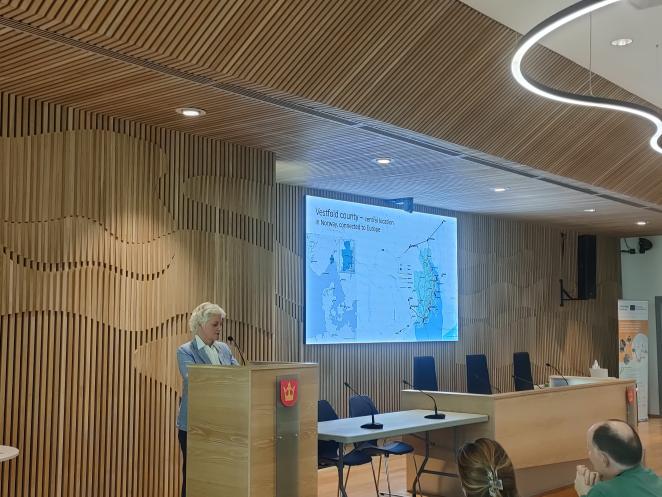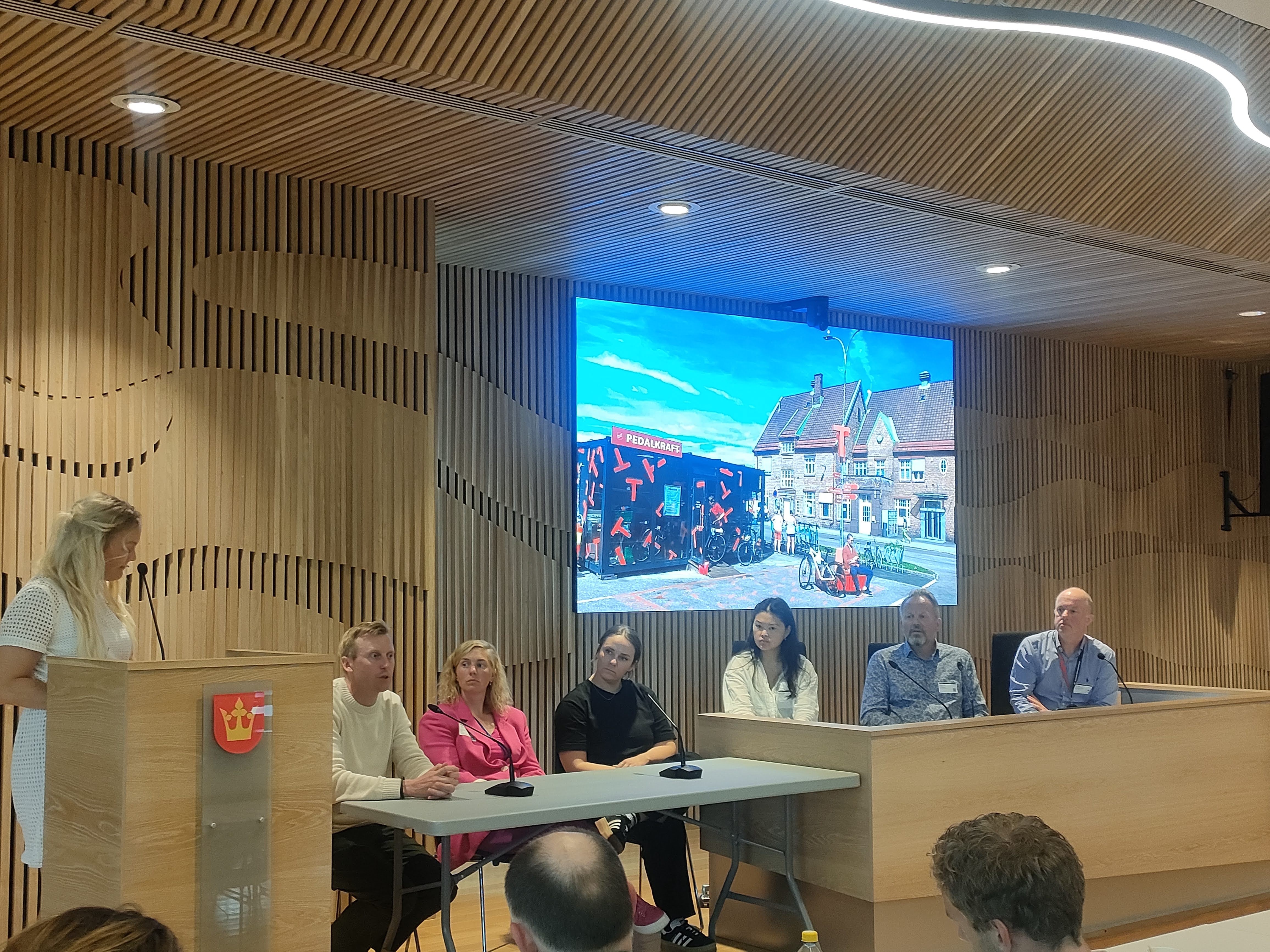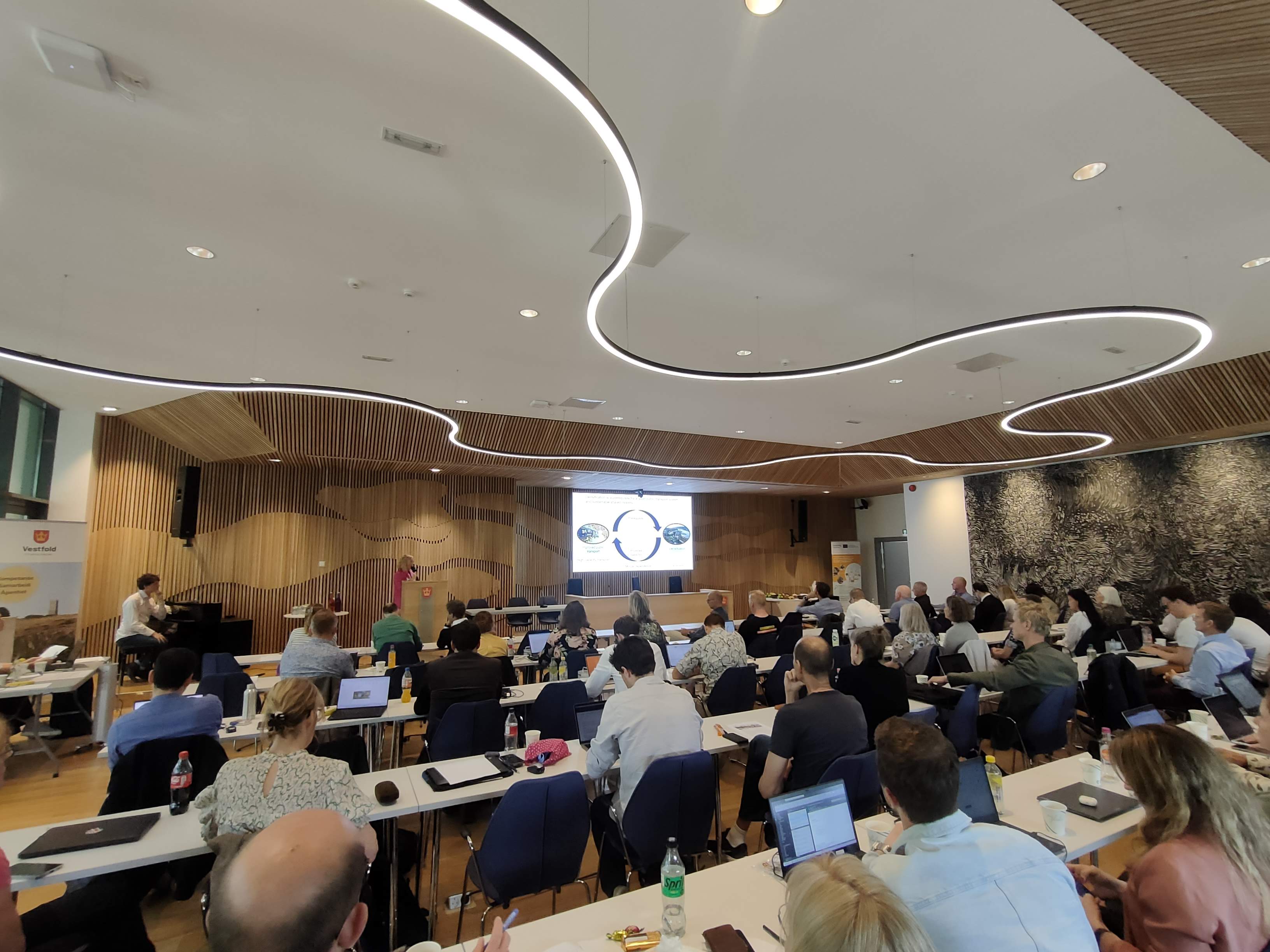Stakeholders from across Europe gathered Tønsberg to discuss the benefits and implementation of Shared and Digital Mobility Hubs.
On May 29, 2024, stakeholders from across Europe gathered at Fylkeshuset in Tønsberg for conference around Shared and Digital Mobility Hubs. Hosted by our project partners, the Vestfold County, the Municipality of Tønsberg and the Norwegian Public Roads Administration, the event aimed to explore the role of shared mobility hubs in enhancing urban and regional transport systems. With a varied array of project partners presenting their local developments, the conference attracted diverse audience, including politicians, civil servants, mobility providers, and academics, who delved into the possibilities and challenges of shared mobility in Norway.

Welcome and Introduction to the Conference
The event opened with a warm welcome by Anne Strømøy, the County Mayor of Vestfold, alongside Frank Pedersen, Mayor of Tønsberg, and Eric van Dijk, representative from ShareDiMobiHub lead partner, the Province of Utrecht. Each leader provided valuable insights into their vision for a more sustainable mobility future.
Anne Strømøy emphasized the urgent need for communities to move away from fossil fuels and highlighted the importance of collaboration with private partners to enhance shared mobility options in less densely populated areas. She stressed the integration of these services with existing public transport systems as crucial for creating comprehensive mobility solutions.
Frank Pedersen shared exciting developments within Tønsberg, including the upcoming tram system connecting to Oslo by 2025 and the city's sustainable mobility plan initiated in 2020. He proudly mentioned Tønsberg's efforts in establishing its first mobility hub, featuring bicycle points and electric mopeds, expressing gratitude for being part of this transformative EU project.
Eric van Dijk discussed the unique challenges faced by rural areas in the Netherlands, underscoring the necessity to include these less densely populated regions in the mobility conversation. He spoke about the need to alter the mobility system and change behaviours while still offering various transport options to ensure no one is left behind.
Part One: Deepening Understanding of Mobility Hubs
Mobility Hubs: What are they?
This section of the conference, led by Jelten Baguet from Mpact, along with Daniel Herrera and Jorge Manso from POLIS Network, delved into the fundamentals of mobility hubs. The speakers explained how these hubs serve as pivotal elements in urban mobility strategies by facilitating the integration of various transport modes into a single physical location. They discussed the roles of different stakeholders, including city planners, transport authorities, and private mobility providers, in developing a network of these hubs. The presentation also covered the typology, quantity, and branding of mobility hubs, illustrating how they can transform urban and regional mobility landscapes.
How to Successfully Integrate Shared Mobility into Mobility Hubs?
Jeffrey Mathijs from Autodelen.net took the stage to showcase successful European models of integrating car sharing and micromobility into mobility hubs. Highlighting the benefits of shared mobility, Mathijs presented a comparative analysis of different shared mobility options across Europe and their impact on modal share. He emphasized three critical elements for success: establishing a robust framework, creating compelling offers that users can't refuse, and implementing a strategic communication plan that fosters collaboration with stakeholders while tailoring messages to diverse target groups and regions. This approach, he argued, is essential for the widespread adoption and effectiveness of shared mobility hubs.
Digital Integration: Decoding the Bits and Bytes of Mobility Hubs
Jelten Baguet from Mpact continued the conference with an enlightening presentation on the digital aspects of mobility hubs. He emphasized the critical role of standardized data in making shared mobility more time-efficient, cost-effective, and easier to monitor and regulate. Baguet highlighted the ongoing development of the Transport Operator to MaaS Provider Application Programming Interface (TOMP-API). This initiative by the TOMP working group aims to establish an internationally recognized open standard for technical communication between transport operators and MaaS providers, ensuring seamless service integration and enhancing user experiences.
Part Two: Panels from Theory to Practice
Exploring the Potential for Shared Mobility in Norway
The panel discussion shifted focus to the practical implementation and potential of shared mobility in Norway. Trine-Marie Molander Fjeldstad from Bane NOR detailed how the railway sector is incorporating mobility hubs into their infrastructure, enhancing the accessibility and convenience for travelers. Karolina Hye Aaland from the Norwegian Public Roads Administration outlined the national strategies to bolster shared micromobility, including comprehensive action plans that support sustainable transportation.
Trond Myhre of Vestfold Kollektivtrafikk discussed the pivotal role regional authorities play in orchestrating shared mobility initiatives, ensuring that services are tailored to meet local needs while aligning with broader transportation goals. Kenneth Wiik from Entur AS delved into how digital platforms can integrate shared mobility solutions with public transport systems, creating a cohesive network that caters to modern commuters.
Thea Martine Samer from Getaround presented their innovative approach to reducing car ownership by transitioning from selling vehicles to providing trip-based solutions. Øystein Sundelin from Voi Technology discussed the impact of shared micromobility on improving multimodal transportation, particularly in urban settings where efficient movement is crucial.

Establishing a Network of Mobility Hubs: Insights from European Cities
The next panel discussion, moderated by Bram Seeuws from Autodelen.net, featured profound insights from European municipal and regional leaders on establishing a robust network of mobility hubs. Angelique Morcus from the Municipality of Amsterdam shared her experiences in integrating these hubs into the city's existing urban landscape, emphasizing the importance of strategic placement and community engagement in their success. Wouter Slob from the Province of Utrecht discussed the challenges and strategies of scaling these hubs across larger regions to ensure consistency and accessibility in rural as well as urban settings.
Lars Ove Kvalbein from the City of Bergen highlighted the technical and logistical considerations involved in developing mobility hubs, such as the integration of technology and the need for resilient infrastructure that can adapt to evolving transportation trends. Magnus Martin from the Municipality of Tønsberg provided insights into the collaborative efforts required to align various stakeholders, including public and private entities, to foster a seamless and efficient mobility network.

Conclusion: A Roadmap for Future Mobility
The Tønsberg event showcased the advantages of shared mobility hubs for enhancing urban and regional transportation. It provided a well-defined plan for incorporating these systems seamlessly into everyday life. The conference emphasized the critical role of collaboration among diverse stakeholders and the use of digital technology in realizing the potential of shared mobility to make cities more sustainable and accessible. By bringing ShareDiMobiHub partners to present their experiences, as well as local operators, the insights gained from this event are set to influence the development of mobility hubs in Norway, aiming for a more sustainable and efficient transportation future.
